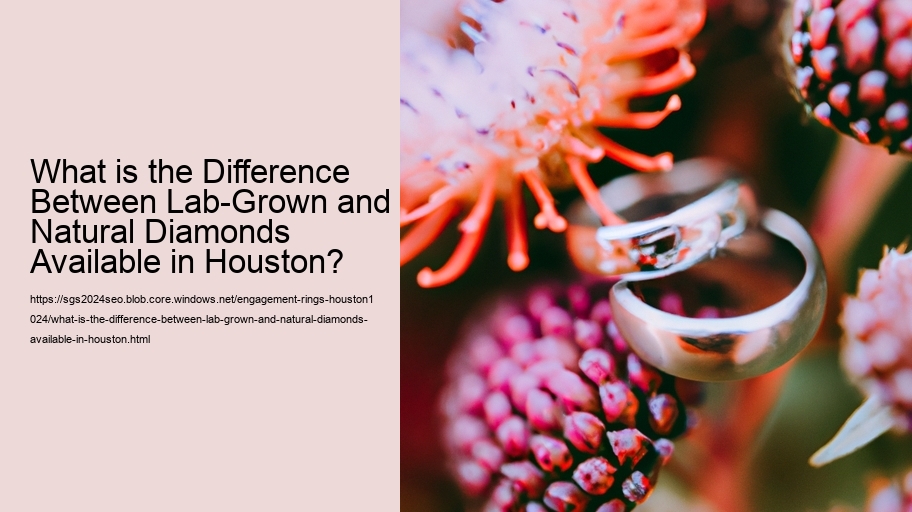Title: What is the Difference Between Lab-Grown and Natural Diamonds Available in Houston?
What is the Average Cost of Engagement Rings in Houston? .
Diamonds have long been cherished for their brilliance, durability, and symbolic representation of love and commitment. As the gemstone market evolves, consumers in Houston and beyond are presented with a choice that wasn't available to previous generations: lab-grown diamonds. Understanding the differences between lab-grown and natural diamonds is crucial to making an informed decision, whether you're purchasing an engagement ring, a piece of fine jewelry, or an investment.
Natural Diamonds: A Product of Time and Nature
Natural diamonds are formed deep within the Earth over billions of years through intense heat and pressure. These geological marvels are brought closer to the Earth's surface by volcanic eruptions, making them accessible for mining. Each natural diamond carries with it a unique history, shaped by the conditions under which it was formed.
The rarity of natural diamonds contributes significantly to their value. The process of extracting these gems involves extensive mining operations that are both time-consuming and costly. Additionally, natural diamonds often have inclusions or slight imperfections, which can add to their uniqueness and character. The journey of a natural diamond from deep within the Earth to a polished gemstone in a Houston jewelry store is a testament to nature's grandeur and the craftsmanship involved in its transformation.
Lab-Grown Diamonds: Innovation and Precision
Lab-grown diamonds, also known as synthetic or cultured diamonds, are created in controlled laboratory environments using advanced technological processes that mimic the natural conditions under which diamonds form. The two primary methods for creating lab-grown diamonds are High Pressure High Temperature (HPHT) and Chemical Vapor Deposition (CVD).
HPHT involves replicating the high pressure and high temperature conditions of the Earth's mantle, while CVD uses a gas mixture to deposit carbon atoms onto a diamond seed, layer by layer. Both methods produce diamonds that are chemically, physically, and optically identical to natural diamonds. In fact, even gemologists require specialized equipment to distinguish between the two.
One of the most notable advantages of lab-grown diamonds is their ethical and environmental implications. The diamond mining industry has historically been associated with environmental degradation and human rights concerns, often referred to as "conflict diamonds" or "blood diamonds." Lab-grown diamonds offer a conflict-free alternative, created with a significantly lower environmental footprint.
Price and Accessibility
One of the most significant differences between lab-grown and natural diamonds is the price. Lab-grown diamonds are generally more affordable than their natural counterparts, often costing 20-40% less. This price difference allows consumers to purchase larger or higher-quality stones within the same budget, making diamond jewelry more accessible to a broader audience in Houston.
Additionally, the supply of lab-grown diamonds is more consistent and predictable, as it is not subject to the same geological limitations as natural diamonds. This consistency can result in a more streamlined and transparent purchasing process, with fewer concerns about the ethical and environmental implications.
Perception and Value
While lab-grown diamonds offer numerous advantages, some consumers still prefer natural diamonds for their historical and emotional significance. Natural diamonds are often seen as a symbol of timelessness and rarity, with each stone possessing a unique story that spans billions of years. This intrinsic value can make natural diamonds more desirable for those seeking a connection to the Earth's history and the romantic allure of a naturally-formed gem.
However, as awareness of the ethical and environmental issues surrounding diamond mining grows, more consumers are turning to lab-grown diamonds as a responsible and sustainable choice. The perception of lab-grown diamonds is evolving, with many viewing them as a modern and innovative alternative that aligns with contemporary values of sustainability and ethical consumption.
Conclusion
In Houston, the choice between lab-grown and natural diamonds ultimately comes down to personal preference and priorities. Both options offer stunning beauty and enduring quality, but they differ in terms of origin, price, ethical considerations, and historical significance. Whether you are drawn to the timeless allure of a natural diamond or the innovative and sustainable appeal of a lab-grown gem, understanding the differences between the two will help you make an informed and meaningful choice for your next diamond purchase.
